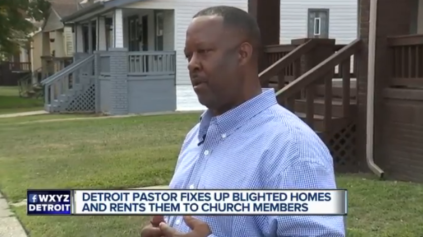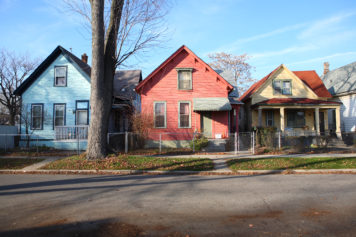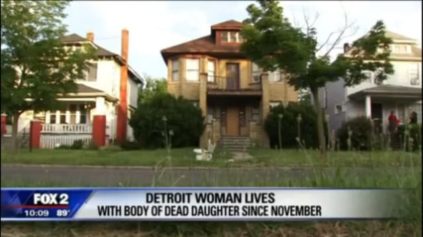The stone marker purposely looks like a tombstone. Approximately 200 activists and media members gathered there late Wednesday afternoon on the 50th anniversary of the Newark riots/rebellion. Many rallied on the main thoroughfare, Springfield Avenue, where the 1967 rebellion started and echoes to this day. On the marker, erected in 1997 on the 30th anniversary, the names of people who were killed by the Newark police, New Jersey State Troopers, the National Guard or some combination thereof are listed.
Meanwhile, Detroit is gearing up for the commemoration of its July 23-July 27 uprising. It is a city where, from the abolitionist era through the Black Power movement, Black people considered violent resistance to white oppression normal, as Black journalist and historian Herb Boyd wrote in his new book, “Black Detroit: A People’s History of Self-Determination.” He called the 1967 disturbances “a tide of revolt.”
Newark went up in flames from July 12 to July 17 when John Smith, a Black cab driver, was beaten by a white officer on Newark’s predominately white police force. People in a nearby housing project thought he had been beaten to death and took to the streets. Detroit’s police-inspired violence happened when the police raided a nightclub on Clairmount and 12th Street. The police raiding of such nightclubs were not uncommon, but within the context of the 1960s, it became a match that lit a fuse. Bystanders reacted to the tactics of the police and the situation became confrontational and ignited the rebellion.
In both instances, the police killed more than two dozen Black people. (Two whites, a police officer and a firefighter, were among the Newark dead, thanks to the actions of the police/National Guard.) No one was ever indicted.
The destruction in—not of—the two major cities in two weeks scared an already racially jumpy America. President Lyndon Baines Johnson commissioned a report to find out what had happened in Detroit, Newark and in dozens of cities in 1967 and why. When the National Advisory Commission on Civil Disorders—nicknamed the Kerner Commission report, named after its chairman, Otto Kerner—released its findings (summary is here), it was buried by Johnson because it was honest about the effects of white racism and poverty on oppressed Black people.
Black Activists: Rebellion, Not Riot
Rebellions. Uprisings. Riots. Disturbances. The noun that is picked says a lot about what a person believes. Words carry immense cultural and political power; In Black activist communities over the last half-century, “rebellion” and “uprising” have replaced both “riot” and the so-called unbiased term “disturbance” as the culturally and politically accurate description.
On a good day, good journalism evolves into good history. But how to describe what happened? Richard Prince, the veteran Black journalist whose “Journal-isms” online column on racial diversity and the American mainstream media has been required reading for journalists of color for more than a decade, was a young reporter covering the 1967 Newark disturbances for The Newark Star-Ledger. As an eyewitness to that bloodied history, what does he now think it should be called? “It isn’t just now that people made language part of the battle for hearts and minds. They did then, too,” Prince said in an email interview. “But the question raised then is still valid: Why tear down your own community if you’re ‘rebelling’?”
If one had asked that question at Wednesday afternoon’s Newark rally, sponsored by the People’s Organization for Progress, a New Jersey activist group, those at the tombstone would have said that people like Prince miss the racism and economic oppression those Black communities suffered under, pre- and post-1967. POP chairman Lawrence Hamm explained to the crowd that a riot is what might happen after a sporting event, while a rebellion is a collective response to collective race and class oppression. “And while none of us would support certain kinds of activities,” Hamm said, “to say that there shouldn’t be a rebellion would be like saying there shouldn’t a hurricane or a tornado or a storm. We don’t like hurricanes, tornadoes or storms, but they are a part of nature. The uprisings of the 1960s were natural responses to what people were experiencing in this country. … The uprising of ’67 was just as much a slave rebellion as our uprising in 1865.”
In Detroit and Newark, the Struggle for Justice and Preserving the Memory of the Dead
Statistics abound about Newark and Detroit’s uprisings. Boyd writes that in Detroit “[i]n the wake of the devastation, there were 43 dead citizens and 473 injured. More than 7,200 were arrested, a few for having mismatched shoes and naked mannequins. Some 2,500 stores were vandalized or torched. There were nearly 400 homeless families, and 412 buildings had to be demolished. The overall damages totaled between $40 [billion] and $80 billion. Among the losses were a popular nightspot, an irreplaceable bookstore, and nearly a block of homes after a gas station exploded.” In Newark 26 died in the uprising, while hundreds were injured. Hundreds of white businesses were destroyed by looters. Black businesses were destroyed by angry white police.
One of those names of the fatally shot in Newark was Eloise Spellman. The mother of 11 was making dinner in her apartment when she was shot right through the window. Her daughter, Kim, 54, now living in New York, stood at the marker with her sister Pam and, through tears, read the names aloud of all the dead from the 1967 New Jersey rebellion.“Rose Abraham…Negroid….homicide shooting….insufficient evidence. Leroy Boyd…Negroid….auto accident….no evidence….” She pointed out that the two whites who died had their evidence recovered, according to the report, but none of the Blacks. At a later point in the march, Hamm called for a re-opening of all the 1967 rebellion’s no-cause cases.
Spellman also spoke about how her family’s tragedy was compounded because her mother was pregnant. “They don’t talk about it. They say 26 victims, but I don’t care, I always say 27, because that would have been my baby brother or sister.”
Cracked Sidewalks vs. a Gentrified Future
In 2017, it is undeniable that the popularity pendulum has swung back in both cities. Newark and Detroit are now in vogue, and are mightily striving to play significant roles in the future of urban America. Ironically, cities that white America once left in the dark are now trying to keep their historic Black populations.
In Detroit, there is rebuilding and rebirth under a white mayor, Mike Duggan. The city is attempting to become, among many other things, a home for artist colonies. Boyd writes the obvious-but-important truism: “[T]he city can achieve its true greatness only when the majority population shares in the incredible growth downtown and this same material energy is duplicated in the neighborhoods.”
Boyd could also be referring to Newark. Mayor Ras Baraka, who late last month announced he would run for re-election, had to publicly quash the growing trend of Newark being called “The Next Brooklyn,” a reference to the gentrification that has overrun the once-majority-Black borough in New York City. When a city has a 6.6 unemployment rate and 60 percent of its population has only a high school diploma/GED or less, it’s not unfair to publicly wonder which of the city’s residents can afford that new Whole Foods or those $2,000-a-month new apartments downtown.
Newark and Detroit are still majority Black and brown cities, and therein lies the power. The Third World-inspired power of Newark and Detroit comes from the idea of Black Americans achieving self-determination through managing and operating a city, making it their own, may be a 20th-century FUBU pipe dream. But reaching for it creates a sense of ownership, even if what is being held—land, buildings, budgets—seems to be more on long-term, white-controlled leases.
The two cities have turned raised Black power fists and Molotov cocktails of the past into a sense of history and responsibility to the current victims of police brutality and government indifference as well as to the centuries of struggle for freedom. And that dual sense applies to the current challenge: make Black and brown humaneness, white capitalism and white authority co-operate and collectively jam to the same drum-laden song.
TODD STEVEN BURROUGHS, Ph.D., is an independent researcher and writer based in Newark, N.J. He is the author of an audiobook, Son-Shine On Cracked Sidewalks, which deals with the 2014 mayoral election of Ras Baraka, the son of the late activist and writer Amiri Baraka, in Newark, N.J. The co-author with Herb Boyd of Civil Rights: Yesterday and Today and co-editor, with Jared A. Ball, full professor in Morgan State University’s School of Global Journalism & Communication, of A Lie of Reinvention: Correcting Manning Marable’s Malcolm X, he is currently co-writing a book, with Wayne J. Dawkins, an associate professor of Morgan State University’s SGJ&C, on Freedomways magazine.


